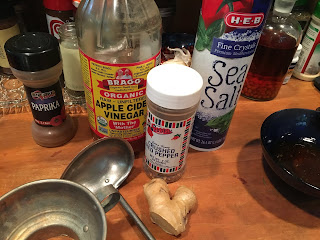Sometimes when you start to think about a subject, you notice more and more references in the world to it. Suddenly it's randomly brought up in conversations, you might see signs for it, or run across it in a store or in the media. So it's been these last few weeks for me with canning.
After two family reunions, visits with cousins, and a trip to the farmers market on my way through Luling, I amassed quite a pantry full of items, more than I've ever had at one time. And such diversity, which really speaks to the bounty of Texas in the different areas that my relatives live, their personal tastes, and what's traditional to their family. I ended up with 16 jars of different things. Above are pickled beets (Don and Gladys Orsak from our Orsak reunion), hot dill pickles from Mikesh Produce in Luling, pear butter (cousin Ann Adams in Floresville), and apricot habanero jelly, made by cousin Rose Cofer and won in the silent auction at the Morkovsky reunion in Hallettsville.
Above are pickled beets from my aunt Karen and uncle Reed Jackson in Denton, pickled okra (Don and Gladys Orsak), orange marmalade (made by first-cousin-once-removed Marilyn Hollis and won at the silent auction at the Orsak reunion in Ganado), and tomato raspberry jam (cousin Ann Adams.)
Above are elderberry jelly (aunt Karen and uncle Reed) and grape jelly, loquat jelly, and pickle relish all from Don and Gladys Orsak.
The last batch above is all from my cousins (also first cousins once removed) Don and Gladys Orsak. I won a whole basket of their fantastic canning efforts in the silent auction of our Orsak reunion in Ganado earlier this month. Above is bread and butter pickles, hot chili petines in vinegar, canned green beans, and canned carrots.
Inspired by all this family creativity, resourcefulness, and industriousness, a week ago my friend Lori and I determined to make kvasena (crock pickles), which is maybe my favorite type of pickle. Lori made a call to a friend who works for Farm to Table to get us enough cucumbers and fresh dill for two gallon jars of pickles, plus a little leftover for a cucumber salad. In a bout of serendipity, at the Morkovsky reunion last weekend, a first-cousin-by-marriage-once-removed offered us each a gallon of well water from his property in Goliad County.
 |
| Ingredients for kvasena. |
Using well water to make the best kvasena is a pervasive family food myth. It may be a myth or maybe it's not. I called my father's "canning hotline" to ask about this and he told me his grandmother, Sophie Zielonka, told him that the high mineral content in well water keeps the pickles crispy longer. Indeed, that's why I like them so much. You can find my kvasena recipe (which is actually my great Aunt Louise's recipe) in a previous blog post here.
After the kvasena endeavor, a friend of Lori's has a friend whose father has a farm in Lockhart and offered produce to Lori, who then called me for a second canning project today. Lori's friend facilitated a hook up of 20+ pounds of tomatoes, plus okra, cucumbers, and bell peppers. Lori suggested making salsa and tomato jam.
The first time I ever had tomato jam was actually at the Smithsonian Folklife Festival in Washington DC. I was a curatorial assistant for the Texas Food and Wine Program that year and had taken the amazing and wonderful Hoover Alexander from Austin, among nine other traditional cooks, to do cooking demonstrations and talk about food and his African-American heritage. He made tomato jam for one of his presentations. But when I asked my father about the jam, he reminded me that his grandparents had a tomato truck farm in Dewitte County near Cuero and said that he remembers eating it frequently at their house.
 |
| Getting the tomatoes ready. |
 |
| Grating the ginger. |
 |
| Fourteen pounds of tomatoes ready for boiling. |
 |
| Lori's mother's canning spoon (Leona (Vasek) Najvar.) |
 |
| Other ingredients to add to the pot for the jam. |
The recipe for the tomato jam Lori and I made was straight from the internet and can be found here, though we processed the jars using the instructions in this recipe. The recipe was certainly different than what my father remembered his grandmother making, which only included tomatoes, sugar, and a little cinnamon.
 |
| Lori's nephew Bryce and me, stirring the pot. |
 |
| This is the stage at which you know the jam is thick enough... when you scrape the spoon across the bottom of the pot and the jam stays where you pushed it. |
 |
| Putting the jars in the canner for processing. |
Since we just finished making the jam, and as I write the jars are boiling away in the canner, I will report back. The jam was delicious out of the pot, though... thick and sweet and savory both with a little kick from the red chili flakes. From 14 pounds of tomatoes, we got 7 pints of deliciousness, which we marveled at... 2 pounds per jar. Incredible. But it's Texas summer preserved in glass and makes me think of hard work and sunshine and friendship... definitely worth the hours of work, especially when you're doing it with friends.
 |
| Cooking and blogging. |







Way Cool! Love it
ReplyDeleteLove this post!
ReplyDeleteI'm going to try the tomato jam, sounds divine.
ReplyDelete